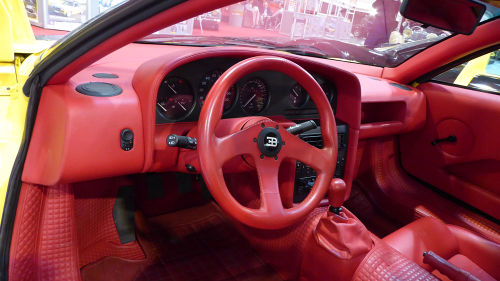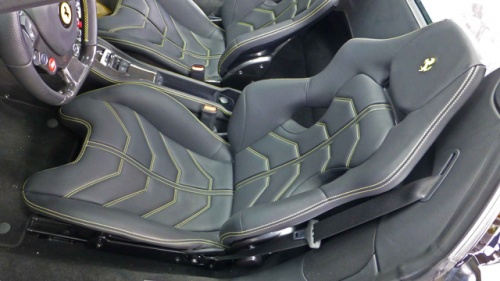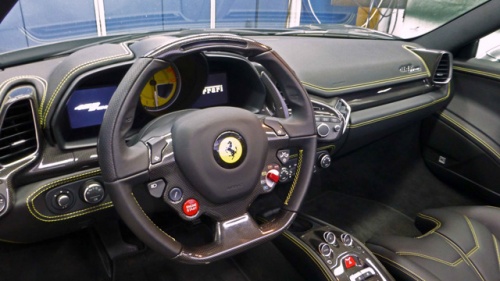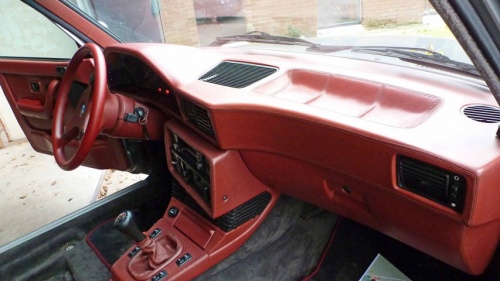Difference between revisions of "Full leather trim"
| (11 intermediate revisions by one user not shown) | |||
| Line 5: | Line 5: | ||
<p align=center> | <p align=center> | ||
| − | [[bild: | + | [[bild:Bugatti-leather-red.jpg|500px]] |
| − | + | ||
</p> | </p> | ||
| − | == | + | ==Full leather trim - Leather appointed - Leather trim== |
| − | + | Car manufacturers sometimes describe the inside of a vehicle as a "full leather interior" or "leather appointed" or "leather trim" with corresponding surcharge. In such cases it is assumed that the entire interior, with a grained smooth surface, is covered with [[leather|genuine leather]] and no [[imitation leather|artificial leather]] or plastic parts have been used. | |
| − | |||
| − | + | <p align=center> | |
| + | [[bild:Ferrari-F142-04.jpg|500px]] | ||
| + | </p> | ||
| − | + | In some countries, the terms "leather trim", "full leather trim" and "partial leather trim" are defined. | |
| − | + | ||
| − | + | According to this, 80% of the expected surfaces of a "leather trim" should be covered with genuine leather. | |
| − | + | For a "full leather trim", all surfaces are expected to be real leather. These include the seats (except the backs), the [[Leather dashboard|dashboard]], the panels, the centre console and also the [[Leather steering wheel|steering wheel]] (outer rim only) and the gear knob. | |
| − | == | + | <p align=center> |
| − | + | [[bild:Ferrari-F142-06.jpg|500px]] | |
| + | </p> | ||
| + | |||
| + | |||
| + | ==Partial leather trim== | ||
| + | The seats in vehicles are not always completely made of leather. Sometimes only the contact surfaces are made of genuine leather, but the side panels, the backs of the backrests and headrests or the armrests are made of [[imitation leather]]. Such seats do not have a "leather trim". The only exceptions are the backs of the seats being a "leather trim". | ||
| + | |||
| + | Partial leather trims are car seats, where some contact areas are made of leather, and the rest is [[Alcantara]], [[imitation leather|artificial leather]] or fabric. However, it is only "partial leather" if at least the middle panels or the outer flanks are made of genuine leather. | ||
| + | |||
| + | |||
| + | ==Mercedes E-Class with artificial leather on leather seats== | ||
| + | The Dailymail in England published an article in March 2018 about a customer who purchased a E-Class Mercedes with seats described in the catalog as "leather seats”. After becoming suspicious about the quality of the material, he sent samples to be tested by a laboratory. The tests revealed that the interior of the seat was leather, but the outer edges of the seat surface were made of [[artificial leather]]. Mercedes then refunded the full purchase price of £ 32,674. According to Mercedes, its main surfaces are leather, and the remaining surfaces can be [[imitation leather]] aka fake leather. This reasoning does not seem valid, as usually the side surfaces are in artificial leather and not the flanks of the upper seat surface (leather parts on the left and right of the horizontal seat). These include the flanks which are known to be [https://www.colourlock.com/How-To-s/Car-Leather/How-to-repair-colour-damages-on-leather-car-seats/ the surfaces of main wear]. Therefore, leather is preferred on flanks as it is the more durable material for these areas. | ||
| + | |||
| + | The immediate refund of the purchase price of the vehicle indicates that Mercedes itself is not convinced by this argument. Conclusion: A clear declaration is the best consumer information and offering customers such seats only as "leather seats" in this price segment is not the way to win customers confidence. | ||
| + | |||
| + | * [[Man made leather|Mercedes and artificial leather: Man made leather]] | ||
| + | |||
| + | |||
| + | ==[[Split leather]] in cars== | ||
| + | The vehicle manufacturers also increasingly use [[Coated leather - Laminated leather|coated]] or [[split leather|embossed split leather]] for door cards and headrests, but also for [[Leather steering wheel|steering wheels]] and gear knobs, without stating this clearly. The buyer acquires in good faith a [[leather quality|high-quality]] "leather interior" or "full leather trim" and receives low quality [[split leather]] on areas outside the contact area. Since these are [[Coated leather - Laminated leather||coated and embossed]], even [[Leather expert - Leather consultant|specialists]] cannot recognise whether it is a more valuable [[Top grain leather|grain leather]] or a cheaper [[split leather]]. Therefore, the purchaser should consciously ask and insist in the purchase contract that they are not buying split leather. | ||
| − | + | For leather furniture, the regulations differ from country to country. In Germany, the regulations state that [[split leather]] should not be used in the contact area, but it must nevertheless be pointed out clearly that it has been used. In this case, the consumer is informed of what he has purchased. It is surprising that this rule exists only for furniture. One must assume that the strong lobby of the car industry in Germany has prevented this regulation for [[car leather|vehicle leather]] and sells cars all around the world where the consumer is not adequately informed about the value of the used materials. | |
<p align=center> | <p align=center> | ||
| − | [[bild:Vollleder-02.jpg| | + | [[bild:Vollleder-02.jpg|500px]] |
| − | + | ||
</p> | </p> | ||
<p align=center> | <p align=center> | ||
| − | ''[[ | + | [[bild:Vollleder-01.jpg|500px]] |
| + | </p> | ||
| + | <p align=center> | ||
| + | ''[[Car leather#BMW|BMW]] E28 M5 of 1986 with full leather trim. Even the area under the roof is made of [[nubuck]], which is unexpected even with a full leather trim.''<br></p> | ||
<p> </p> | <p> </p> | ||
<p align=center> | <p align=center> | ||
| − | [[bild:Teillederausstattung-01.jpg| | + | [[bild:Teillederausstattung-01.jpg|500px]] |
| − | + | ||
</p> | </p> | ||
<p align=center> | <p align=center> | ||
| − | '' | + | [[bild:Opel-Omega-A-3000-1988.jpg|500px]] |
| + | </p> | ||
| + | <p align=center> | ||
| + | ''Classic partial leather interior. - Partial leather interior the [[car leather#Opel|Opel]] Omega.''<br></p> | ||
<p> </p> | <p> </p> | ||
| Line 52: | Line 74: | ||
</p> | </p> | ||
<p align=center> | <p align=center> | ||
| − | ''[[ | + | ''[[Car leather#BMW|BMW]] Z1 "fun yellow" with partial leather interior.''<br></p> |
<p> </p> | <p> </p> | ||
| Line 60: | Line 82: | ||
</p> | </p> | ||
<p align=center> | <p align=center> | ||
| − | + | ''Lancia with [[Alcantara]]-leather-combination. - [[car leather#BMW|BMW]] X3 with partial leather interior.''<br></p> | |
<p> </p> | <p> </p> | ||
<p align=center> | <p align=center> | ||
| − | [[bild:Mercedes1978.jpg| | + | [[bild:Mercedes1978.jpg|500px]] |
| − | + | ||
</p> | </p> | ||
<p align=center> | <p align=center> | ||
| − | '' | + | [[bild:VW-Golf-Aigner.jpg|500px]] |
| + | </p> | ||
| + | <p align=center> | ||
| + | ''No partial leather interior: [[car leather#Mercedes|Mercedes]] Fabric-[[Man made leather|artificial leather]]-combination and Volkswagen Golf "Aigner" (not enough leather to call it "partial leather interior").''<br></p> | ||
<p> </p> | <p> </p> | ||
| Line 76: | Line 100: | ||
</p> | </p> | ||
<p align=center> | <p align=center> | ||
| − | ''[[ | + | ''[[Car leather#BMW|BMW]] partial leather interior. Black leather outside, inside fabric woven with [[leather strips]].''<br></p> |
<p> </p> | <p> </p> | ||
| − | |||
| − | |||
| − | |||
== Additional information == | == Additional information == | ||
| Line 86: | Line 107: | ||
* [[Leather dashboard]] | * [[Leather dashboard]] | ||
* [[Leather steering wheel]] | * [[Leather steering wheel]] | ||
| + | * [[Man made leather]] | ||
Latest revision as of 16:52, 19 December 2022
Contents
Full leather trim - Leather appointed - Leather trim
Car manufacturers sometimes describe the inside of a vehicle as a "full leather interior" or "leather appointed" or "leather trim" with corresponding surcharge. In such cases it is assumed that the entire interior, with a grained smooth surface, is covered with genuine leather and no artificial leather or plastic parts have been used.
In some countries, the terms "leather trim", "full leather trim" and "partial leather trim" are defined.
According to this, 80% of the expected surfaces of a "leather trim" should be covered with genuine leather.
For a "full leather trim", all surfaces are expected to be real leather. These include the seats (except the backs), the dashboard, the panels, the centre console and also the steering wheel (outer rim only) and the gear knob.
Partial leather trim
The seats in vehicles are not always completely made of leather. Sometimes only the contact surfaces are made of genuine leather, but the side panels, the backs of the backrests and headrests or the armrests are made of imitation leather. Such seats do not have a "leather trim". The only exceptions are the backs of the seats being a "leather trim".
Partial leather trims are car seats, where some contact areas are made of leather, and the rest is Alcantara, artificial leather or fabric. However, it is only "partial leather" if at least the middle panels or the outer flanks are made of genuine leather.
Mercedes E-Class with artificial leather on leather seats
The Dailymail in England published an article in March 2018 about a customer who purchased a E-Class Mercedes with seats described in the catalog as "leather seats”. After becoming suspicious about the quality of the material, he sent samples to be tested by a laboratory. The tests revealed that the interior of the seat was leather, but the outer edges of the seat surface were made of artificial leather. Mercedes then refunded the full purchase price of £ 32,674. According to Mercedes, its main surfaces are leather, and the remaining surfaces can be imitation leather aka fake leather. This reasoning does not seem valid, as usually the side surfaces are in artificial leather and not the flanks of the upper seat surface (leather parts on the left and right of the horizontal seat). These include the flanks which are known to be the surfaces of main wear. Therefore, leather is preferred on flanks as it is the more durable material for these areas.
The immediate refund of the purchase price of the vehicle indicates that Mercedes itself is not convinced by this argument. Conclusion: A clear declaration is the best consumer information and offering customers such seats only as "leather seats" in this price segment is not the way to win customers confidence.
Split leather in cars
The vehicle manufacturers also increasingly use coated or embossed split leather for door cards and headrests, but also for steering wheels and gear knobs, without stating this clearly. The buyer acquires in good faith a high-quality "leather interior" or "full leather trim" and receives low quality split leather on areas outside the contact area. Since these are |coated and embossed, even specialists cannot recognise whether it is a more valuable grain leather or a cheaper split leather. Therefore, the purchaser should consciously ask and insist in the purchase contract that they are not buying split leather.
For leather furniture, the regulations differ from country to country. In Germany, the regulations state that split leather should not be used in the contact area, but it must nevertheless be pointed out clearly that it has been used. In this case, the consumer is informed of what he has purchased. It is surprising that this rule exists only for furniture. One must assume that the strong lobby of the car industry in Germany has prevented this regulation for vehicle leather and sells cars all around the world where the consumer is not adequately informed about the value of the used materials.
BMW E28 M5 of 1986 with full leather trim. Even the area under the roof is made of nubuck, which is unexpected even with a full leather trim.
Classic partial leather interior. - Partial leather interior the Opel Omega.
BMW Z1 "fun yellow" with partial leather interior.
Lancia with Alcantara-leather-combination. - BMW X3 with partial leather interior.
No partial leather interior: Mercedes Fabric-artificial leather-combination and Volkswagen Golf "Aigner" (not enough leather to call it "partial leather interior").
BMW partial leather interior. Black leather outside, inside fabric woven with leather strips.
Additional information





















 a kotori web solution
a kotori web solution